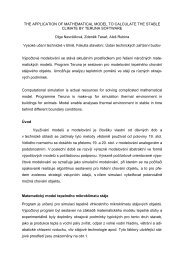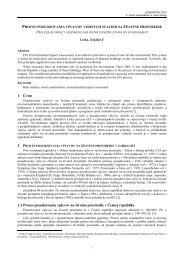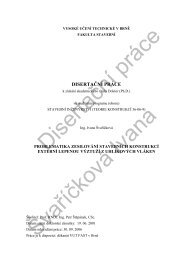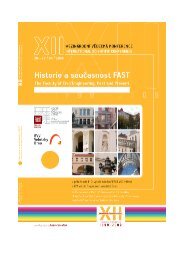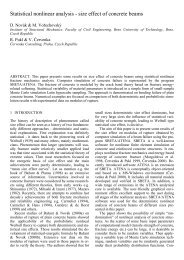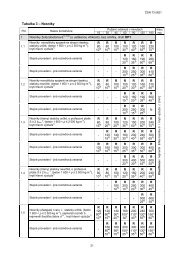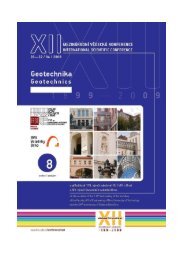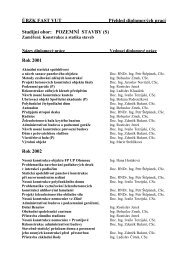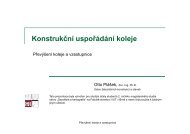Dopravnàstavby - Fakulta stavebnà- Vysoké uÄÂenàtechnické v Brně
Dopravnàstavby - Fakulta stavebnà- Vysoké uÄÂenàtechnické v Brně
Dopravnàstavby - Fakulta stavebnà- Vysoké uÄÂenàtechnické v Brně
Create successful ePaper yourself
Turn your PDF publications into a flip-book with our unique Google optimized e-Paper software.
6212th International Scientific Conference, April 20-22, 2009 Brno, Czech RepublicConclusionThe use of steel crash barriers is routine. In the Czech Republic they are used to almost 100%.A partly damaged steel crash barrier continues to discharge its function. Steel crash barriers pointthe direction more visibly. The condition of steel crash barriers may be monitored visually. Steelcrash barriers are used among other things around bridge piers to avoid hard impact.Cable crash barriers were initiated for use by the Road and Motorway Directorate of the CR.Application was accompanied by the need for approval. Cable crash barriers have not been testedand used world-wide. The use of cable crash barriers was banned in Norway in 2006. A cable crashbarrier with a fallen wire rope or also at a loosened tension does not perform its restraint functionuntil the time of its repair and return to normal tension. It allows the passage of snow more. As animportant standpoint there has also been considered the monopoly position of a cable crash barriersproducer.In general it is necessary to re-evaluate the use of places for installing crash barriers andpossibly place them elsewhere e.g. also next to toll gates.A mid-lane with an asphalt surface for a provisional override in an opposite direction willrelease more easily with a steel crash barrier than with a cable crash barrier, where a long section isput out of traffic.From the opinions of professional respondents (from a number of work centres – Departmentof Road Structures, Department of Mechanics, Department of Steel and Timber Structures,Department of Concrete and Masonry Structures, Department of Landscape Engineering,Department of Social Sciences, Department of Construction Technology, Department of Economicsand Management in Civil Engineering, etc.) there emerged a recommended order of applicability:as the most appropriate solution, from the viewpoint of the benefit and risk of crash barriers athighway constructions, is the variant using steel crash barriers, and in the second and third place inclose sequence were cable and concrete crash barriers. Gaining the opinions of respondents andthose derived from their specialist standpoint may be appraised as very valuable.This outcome has been achieved with the financial support of the Ministry of Education, Youthand Sports of the Czech Republic, project No. 1M0579, within activities of the CIDEAS researchcentre.References[1] D. ČÁPOVÁ, L. KREMLOVÁ, R. SCHNEIDEROVÁ, J. TOMÁNKOVÁ: Modelling of theinterdependencies in renovation and maintenance processes during building life cycles,Technical Sheets 2005, CIDEAS, 2006, pp. 3-4.[2] V. BERAN, Z. PROSTĚJOVSKÁ, P. DLASK, E. HROMADA: Methods of Life Cycle CostAnalysis. Workshop 2008, Czech Technical University in Prague, 2008, pp. 3-4.[3] F. LEHOVEC: The Influence of Road InfrastruCzech Technical Universityre on RegionalDevelopment. Proceedings of the Fourth International Scientic Conference "Challenges inTransport and Communication", 2006, pp. 177-182.[4] D. MĚŠŤANOVÁ: Proces EIA a moderní formy monitorování umisťování staveb.Management stavebnictví, Akademické nakladatelství CERM, 2008, pp. 55-56.



